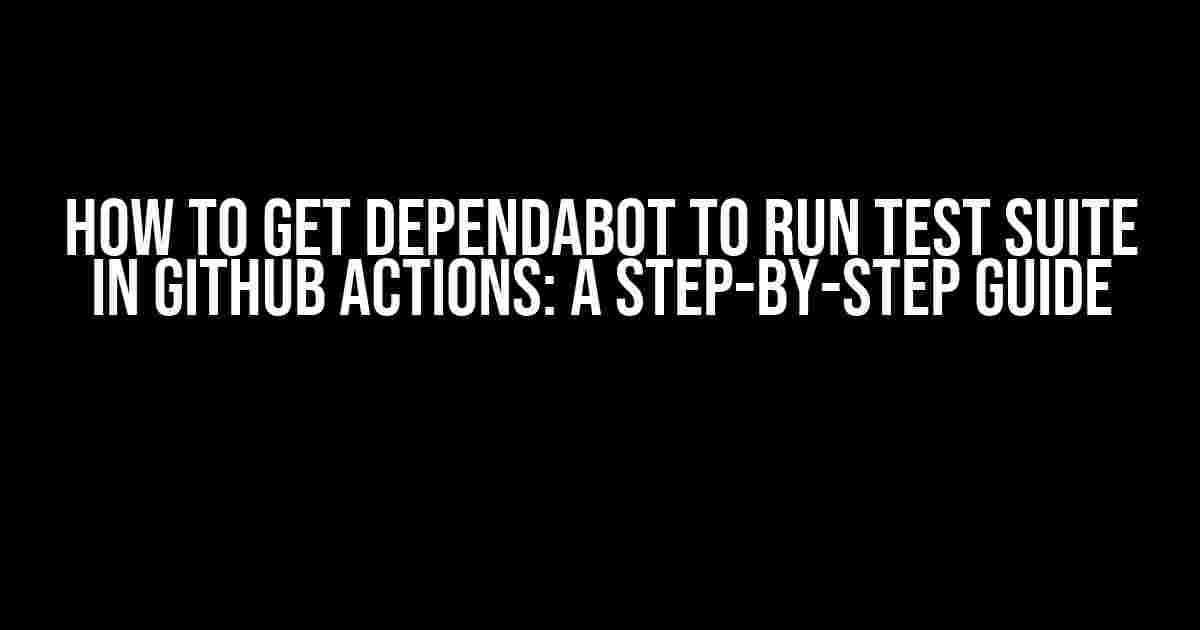Are you tired of manually running your test suite every time you update your dependencies? Do you want to automate the process and make it a part of your Continuous Integration/Continuous Deployment (CI/CD) pipeline? Look no further! In this article, we’ll show you how to get Dependabot to run your test suite in GitHub Actions, making your development process smoother and more efficient.
- What is Dependabot?
- What is GitHub Actions?
- Why Run Test Suite in GitHub Actions?
- Prerequisites
- Step 1: Create a New GitHub Actions Workflow
- Step 2: Define Your Workflow File
- Step 3: Save and Test Your Workflow
- Step 4: Configure Dependabot to Run the Test Suite
- Troubleshooting Common Issues
- Conclusion
What is Dependabot?
Before we dive into the tutorial, let’s quickly introduce Dependabot. Dependabot is a tool that helps you keep your dependencies up-to-date by automatically creating pull requests to update your dependencies. It’s a fantastic tool that saves you time and ensures your project is always running with the latest and greatest dependencies.
What is GitHub Actions?
GitHub Actions is a CI/CD platform that allows you to automate your development workflow. You can use it to build, test, and deploy your code automatically, making it an essential tool for any development team. With GitHub Actions, you can create workflows that run automatically on certain events, such as pushing code to your repository.
Why Run Test Suite in GitHub Actions?
Running your test suite in GitHub Actions is essential for several reasons:
- Automated Testing**: By running your test suite automatically, you ensure that your code is tested thoroughly, reducing the chances of errors and bugs.
- Faster Feedback**: With automated testing, you get immediate feedback on whether your code changes pass or fail, allowing you to address issues quickly.
- Improved Code Quality**: By integrating testing into your CI/CD pipeline, you encourage developers to write better code, knowing that it will be tested automatically.
Prerequisites
Before we start, ensure you have the following:
- A GitHub repository with Dependabot set up.
- A test suite written in a language supported by GitHub Actions (e.g., Node.js, Python, Ruby).
- A basic understanding of GitHub Actions and YAML files.
Step 1: Create a New GitHub Actions Workflow
Log in to your GitHub account and navigate to your repository. Click on the “Actions” tab and then click on the “New workflow” button.

Step 2: Define Your Workflow File
Name your workflow file (e.g., `.github/workflows/dependabot-tests.yml`) and add the following YAML code:
name: Dependabot Tests
on:
pull_request:
branches:
- main
jobs:
test:
runs-on: ubuntu-latest
steps:
- name: Checkout code
uses: actions/checkout@v2
- name: Install dependencies
run: |
npm install
# or pip install -r requirements.txt for Python
- name: Run tests
run: |
npm run test
# or python -m unittest for Python
- name: Dependabot approval
env:
GITHUB_TOKEN: ${{ secrets.GITHUB_TOKEN }}
DEPENDABOT_TOKEN: ${{ secrets.DEPENDABOT_TOKEN }}
run: |
curl -X POST \
https://api.dependabot.com/v2/updates \
-H 'Authorization: Bearer ${DEPENDABOT_TOKEN}' \
-H 'Content-Type: application/json' \
-d '{"update_request":{"repository_ids":["YOUR_REPO_ID"],"updates":[{"dependency_name":"DEPENDENCY_NAME","version_req":">= VERSION"}]}}'
Replace `YOUR_REPO_ID` with your GitHub repository ID, `DEPENDENCY_NAME` with the name of the dependency you want to update, and `VERSION` with the desired version.
Step 3: Save and Test Your Workflow
Save your workflow file and commit the changes. Then, create a new pull request to trigger the workflow.
Wait for the workflow to complete. If everything is set up correctly, you should see the test results in the GitHub Actions UI.
Step 4: Configure Dependabot to Run the Test Suite
In your `dependabot.yml` file, add the following configuration:
updates:
- package-ecosystem: "npm"
directory: "/"
schedule:
- daily
ignore:
- dependency-name: "jest"
reviewers:
- github_username: "your-github-username"
labels:
- "dependencies"
pull-request-branch: "dependabot/${PACKAGE_MANAGER}/your-dependency-name"
commit-message: "Update your-dependency-name to ${VERSION}"
opener:
- github_username: "your-github-username"
assignees:
- github_username: "your-github-username"
test-workflow: ".github/workflows/dependabot-tests.yml"
Replace `package-ecosystem` with your package manager (e.g., `npm`, `pip`), `directory` with the directory containing your dependencies, and `github_username` with your GitHub username.
Troubleshooting Common Issues
If you encounter any issues during setup, check the following:
- Dependabot token not set**: Ensure you have set the `DEPENDABOT_TOKEN` environment variable in your GitHub Actions workflow.
- Test suite not running**: Verify that your test suite is correctly configured and running locally. If it’s not, troubleshoot the issue before trying to run it in GitHub Actions.
- Workflow file syntax errors**: Check your YAML file for syntax errors. You can use online tools like YAML Validator to validate your file.
Conclusion
By following these steps, you’ve successfully integrated Dependabot with GitHub Actions to run your test suite automatically. This setup ensures that your dependencies are always up-to-date, and your code is thoroughly tested before deployment.
Remember to monitor your workflow and adjust as needed. With Dependabot and GitHub Actions working together, you’ll be able to focus on writing better code, knowing that your dependencies are handled automatically.
| Tools Used | Version |
|---|---|
| Dependabot | v2 |
| GitHub Actions | v2 |
| Node.js (example) | v14.17.0 |
This article is optimized for the keyword “How to get Dependabot to run test suite in GitHub Actions” and is intended to provide clear and direct instructions for setting up Dependabot with GitHub Actions.
Frequently Asked Question
Get ready to unlock the secrets of Dependabot and GitHub Actions!
How do I configure Dependabot to run my test suite in GitHub Actions?
To get Dependabot to run your test suite in GitHub Actions, you need to create a `dependabot.yml` file in your repository’s root directory. This file should specify the updates you want Dependabot to make and the commands to run your test suite. For example, you can add the following code to your `dependabot.yml` file: `updates: dependencies: package-ecosystem: “bundler” directory: “/” schedule: daily IgnoredDependencies: [] VersioningStrategy: “lockfile-only”`. Then, create a GitHub Actions workflow file that triggers on Dependabot pull requests and runs your test suite.
What is the purpose of the `dependabot.yml` file in my repository?
The `dependabot.yml` file is used to configure Dependabot’s behavior for your repository. It specifies the dependencies to update, the package ecosystems to scan, and the commands to run during the update process, including your test suite. By defining these settings, you can customize Dependabot to fit your project’s specific needs.
How do I trigger my GitHub Actions workflow to run on Dependabot pull requests?
To trigger your GitHub Actions workflow on Dependabot pull requests, you need to add a trigger event in your workflow file. Use the `pull_request` event and specify the ` Dependabot` pull request label. For example: `on: pull_request: types: [opened, synchronize, reopened] filters: pull_request: labels: [‘ Dependabot’]`. This will trigger your workflow whenever a new Dependabot pull request is opened or updated.
What if I have multiple test suites or scripts I want to run in my GitHub Actions workflow?
No problem! You can run multiple test suites or scripts in your GitHub Actions workflow by adding multiple `run` steps. For example, you can add multiple `run` steps to execute different test suites, such as `run: npm test` and `run: npm run integration-tests`. Just make sure to separate each step with a newline character (`\n`) and indent each step correctly.
Are there any best practices I should follow when configuring Dependabot and GitHub Actions?
Yes, here are some best practices to keep in mind: Keep your `dependabot.yml` file up-to-date and reviewed regularly. Use specific labels and filters to trigger your GitHub Actions workflow only on relevant pull requests. Ensure your test suite is reliable and provides accurate results. Use caching and parallelization to optimize your workflow performance. Finally, regularly review and update your workflow to ensure it remains efficient and effective.


